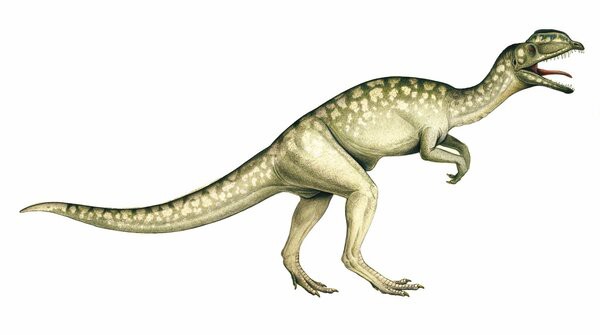Many plant-eating dinosaurs lived together, walked together (and stepped on each other's toes and tails), and died together. Evidence of this can be seen in communal nesting sites, bone lesions, tracks and bone beds. What does this mean for our understanding of dinosaur life?
We know from research that life in groups is complex. Animals need to figure out who is who, compete for social status, and compete for mates. Success in these areas requires strength or size, the display of characteristics such as horns or antlers, or the performance of certain behaviors. If we could detect any of these in dinosaur fossils, it would suggest they faced similar concerns—and we'd need to take another look at their spikes, horns, and elaborate headdresses.
The advantages of grazing can be seen in modern animals. Large numbers reduce the risk of attack from predators and help raise offspring. A Centrosaurus apertus bone bed in Alberta, Canada, that was drowned about 75 million years ago, contains the remains of more than 300 individuals of various age groups, which is strong evidence that they lived in groups.
Our view of solitary predators is changing. Recent fossil discoveries indicate that some animals lived in cooperative groups, raised young, and could be very social. This helps break the "built purely to kill" stereotype, but it also creates a whole new set of problems. Is the group family-based, male- or female-led, or something else? Do they hunt in packs or compete for social status and mates? Fossils, while interesting, don't provide a clear answer. Our only insights come from living predators—which simply tell us that theropods likely interacted with each other in many ways.
Lions live in male-dominated groups of 4 to 40 lions, but females are the primary predators.
Komodo dragons are mostly solitary and they gather together only to breed and eat. However, the dominant male eats first.
Tasmanian devils tend to live and hunt alone. However, they often gather in large groups when feeding and share the spoils of the hunt.
Wolves live and hunt in family groups consisting of a breeding pair, non-breeding adults, and pups.
Alligators are usually solitary, although hatchlings tend to stay together and some species will continue to live in family groups. Food brings large aggregations, and some species hunt cooperatively.
Deinonychus fossils in Montana provide some evidence for group hunting, as all the dinosaurs apparently died at the same time. However, it is also possible that their deaths were due to fighting over recent kills rather than cooperative hunting.
Monophosaurus jiangji was a strange-looking theropod dinosaur that lived in Asia about 170 million years ago. The bony crest on its head may have been used as a display function to attract mates or amplify its calls.
Giganotosaurus belongs to the same group as the North American Allosaurus and had three fingers on each hand, a characteristic feature of Allosaurus. When Tyrannosaurus rex was discovered in 1995, it overtook Tyrannosaurus rex as the largest carnivorous dinosaur. Giganotosaurus may have lived in the family, as at least four dinosaurs of different ages have been found in fossil bone beds in Argentina.
Cryolophosaurus had a crest over its eyes, facial humps, and horns. They are relatively fragile, so were likely used for courtship displays. Cryolophosaurus was discovered in Antarctica. Although living in Antarctica is relatively warm, the winter nights are long and still cool.
Dilophosaurus had two prominent head crests, which may have been used in courtship displays or to help identify other members of the same species. Three individuals were found in the fossil bone bed, suggesting that Dilophosaurus lived in small groups. As a medium-sized theropod, hunting in packs allowed it to capture larger prey.

animal tags: Dinosaur
We created this article in conjunction with AI technology, then made sure it was fact-checked and edited by a Animals Top editor.